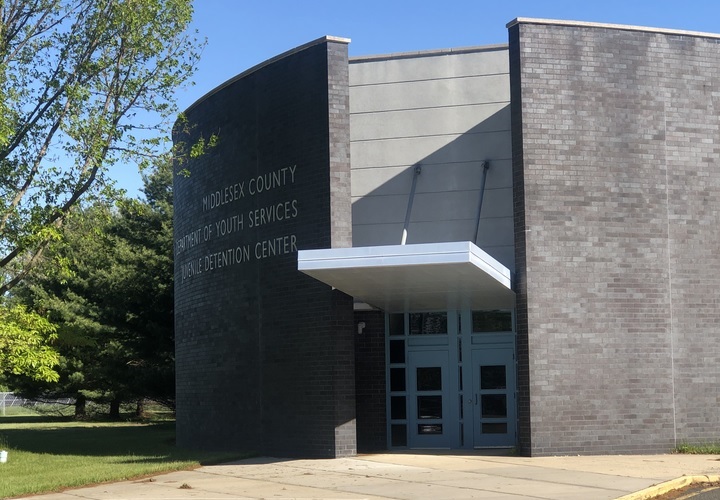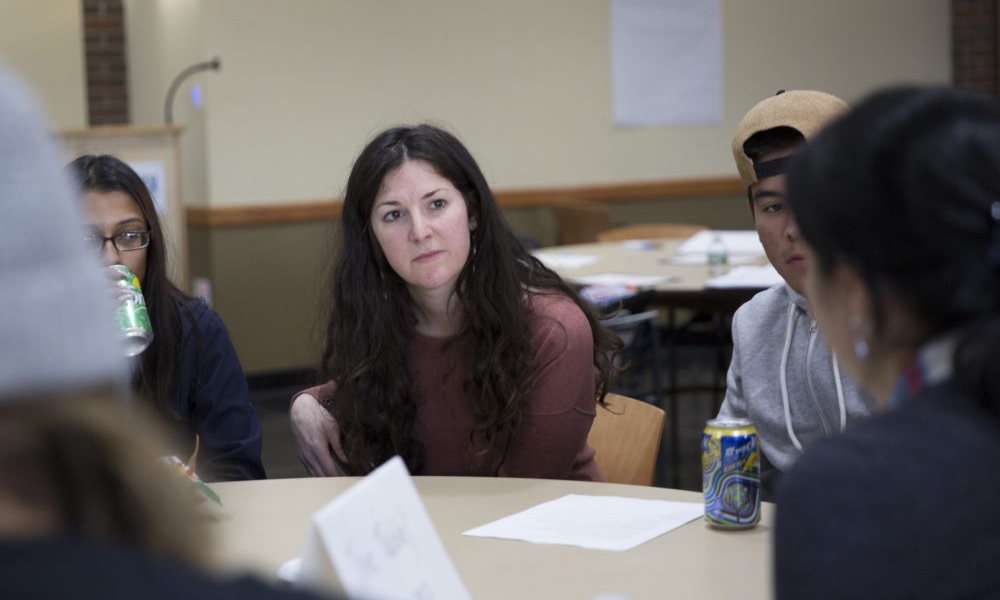Four years ago, a social worker from the Middlesex County Juvenile Detention Center asked English professor Alexandra Fields, of nearby Middlesex College, if she would be able to provide college programming for youth incarcerated at that New Jersey facility. Beyond helping them earn their high school diplomas, it offered nothing more educationally to those graduates.
Because of what had been a short duration of detention – typically, only weeks or months – little thought was given to post-high school programming, Field replied, initially.
But that social worker’s query was prompted by a growing number of teenagers, charged as adults, spending exceedingly more time awaiting sentencing in that New Brunswick detention center. “I have a kid that has been in there for six years,” added Fields, also the Middlesex College Center for Justice-Impacted Students’ academic director.
For that group with extended stays in detention, Fields and her Middlesex undergraduates developed informal workshops about topics including how to apply for college and a book club for incarcerated high school grads. By spring 2021, those early efforts yielded college-credit English composition in New Jersey’s Middlesex County and Camden County juvenile detention facilities and a new associate’s degree program for youth and young adults incarcerated in all 12 male New Jersey Juvenile Justice Commission facilities.
In mid-February 2022, 20 young men across eight of the facilities started working on an associate’s degree from Middlesex, becoming the first such cohort in New Jersey to be on a path toward a college degree. Plans are being laid to expand the program to incarcerated young women, Fields said.
Several states plan college classes for incarcerated youth, young adults
A spokesperson for the Vera Institute, which has provided technical support for college programs in adult prisons in various states, said they were not aware of any comprehensive tally of states teaching college courses in juvenile facilities.

Courtesy of Alexandra Fields
The Middlesex County Juvenile Detention Center in New Jersey.
But a snapshot shows that, along with New Jersey, Utah and California are among states that have increased access to higher education for incarcerated young people. Those efforts partly stem from juvenile justice reforms that keep some young adults in juvenile facilities longer, rather than transferring them to adult facilities when they turn 18. States including Washington and Oregon allow some youth sentenced as adults to remain in the juvenile system until they are 25.
“Our population is shifting,” said Brett Peterson, director of Utah’s Division of Juvenile Justice Services, which oversees five long-term secure facilities for persons up to age 25. “We’re keeping younger, lower-risk youth out of the system. We house youth into young adulthood more commonly now. And, so, we needed to start aggressively thinking about programming.”
Last year, the Utah State Legislature allocated $300,000 in what officials said would be annual funding for a program enrolling incarcerated youth in remote college classes through Dixie State University in St. George, Utah. High school students can take college classes before they graduate and high school graduates are able to start working on their associate’s degree. The program uses the same distance learning technology that the state implemented to deliver college classes to rural high schools.
Instruction is considered critical for younger, still developing brains
Those reforms in Utah and elsewhere, in part, are driven by research on adolescent development, suggesting that young people’s brains aren’t fully formed until their early to mid-20s. That’s another reason why having access to higher education can be critical for incarcerated youth, experts say.
Unlike adult prisons, juvenile detention facilities, in theory, centrally are focused on rehabilitation, said Katie Bliss, project coordinator at the Youth Law Center, a San Francisco-based nonprofit that was one of those successfully pushing for a 2019 law requiring juvenile facilities in California to offer college classes. “We’re talking about key developmental periods,” she said. “It’s really setting the stage for the rest of their lives.”
About 60 of the roughly 80 young people confined to Utah’s juvenile facilities have benefitted from the new law. Eighteen-year-old A.A. is one of them. (Utah officials allowed their charges to be interviewed and identified only by their initials for this news article.)
Taking college classes from Dixie State changed her perspective on education. “I didn’t really like school to begin with, but I’m starting to like it,” A.A. said.
The best thing about it? “I like the part where you think something is hard, and then you get it,” she said. “It makes you feel smart.”
In California, the 2019 reforms have required the state’s three youth prisons (which, except in rare circumstances, will stop accepting juveniles in June 2023, when local governments will start handling detention of juveniles from their jurisdictions) and 59 county probation departments to provide incarcerated juveniles access to college classes as well as career and technical education. More recently, San Francisco State University’s College of Ethnic Studies launched the first certificate program in California that a four-year university offers inside state youth prisons. (Read an essay by a student in that program).
The pool of college-age incarcerated youth is growing
Juvenile justice reforms in a number of other states, too, have increased the pool of college-age persons incarcerated in youth prisons. In 2018, Vermont became the first state to “raise the age” of when a person can be tried as an adult to 18, automatically keeping most 18-year-olds in the juvenile system. Since then, Michigan and New York have followed suit.
Colorado has separate adult facilities for young people that provide more education and rehabilitative services, including a Second Chance Pell program allowing young adults to earn an associate’s degree through Trinidad State College. As of 2020, the Second Chance Pell program offered federal financial aid to prisoners at 130 colleges in 42 states, with full Pell Grant restoration slated to begin in July 2023.
Connecticut and Washington, D.C. are among states that have created special housing units within adult facilities for 18- to 25-year-olds. Those in that age group who refuse to participate in classes, including ones addressing their behavioral health disorders, consequently, can be transferred to an adult prison.
Reforms to keep young adults in the juvenile system can be complicated, the law center’s Bliss said. In some places with declining populations of youth in custody, partly due to diversion programs aimed at keeping them out from behind bars, officials sometimes want to extend the age range as a way to keep facilities open. That’s wrong-headed, she said. This, “should not be about keeping youth in the system for longer, it should be about recognizing that developmental science shows that young adults have great capacity for change.”
Critics: Education in juvenile facilities often is inadequate
Though juvenile facilities, ideally, are supposed to put more focus on rehabilitation than the adult system does, the secondary education offered to incarcerated youth often lacks rigor and doesn’t promote college readiness. A study from Washington state found that 36% of youth who had been in juvenile detention were enrolled in college compared to 51% of their peers who had not been detained. Only 2% of detained students attended a four-year college as opposed to 26% of non-detained students.
A 2019 analysis found that students in juvenile facilities had less access to higher-level math and science courses than their peers in traditional schools. For example, students attending juvenile justice schools were 25% less likely to have access to algebra I, a foundational class required for graduation and for college prep. The same study showed that only 1% of juvenile justice schools had dual enrollment courses, allowing high school students to take college courses; more than half of traditional high schools offer dual enrollment.
And the states that have raised the upper age for keeping young people in the juvenile system have faced challenges as they try to accommodate more young adults. At the end of January, Vermont hit pause on expanding plans to keep most 19-year-olds in the juvenile system while it puts “services in place to deal with this age group,” Erica Marthage, Bennington County state’s attorney told the Bennington Banner newspaper.
A recent article by the Times Union newspapers in Albany, N.Y., posited that “the programs that were supposed to support the state’s Raise the Age statute … have arguably failed to provide many of those teenagers with the services needed to rehabilitate and reintegrate them into their communities.” That law added 16- and 17-year-olds to the list of minors who cannot automatically be tried as adults for felony crimes.
“With ‘raise the age,’ building out community college and higher ed programs is about making sure that students who graduate from high school have access to a supportive array of reentry and diversion services,” Bliss said, adding that college programs in detention facilities should never be a justification for keeping youth locked up.
“It makes me feel like I’m not just locked up”
Those programs in California, New Jersey and Utah serve as degree pathways for high school graduates, but also provide more challenging classes for current high school students, said Bliss of the Youth Law Center.
J.G., 18, has been taking college classes from Dixie State since he graduated from high school while incarcerated last November. “I didn’t know what I wanted to do with my future, so I decided to give it a chance,” he said.
In his favorite class, ethics, he’s currently learning about economist Adam Smith and utilitarianism. He enjoys “understanding the what’s and the why’s of everything.”
J.G. is set to be released from the Division of Juvenile Justice Services this month, but he’ll be able to finish the semester online. Nathan Caplin, director of the Dixie State program, said he’s hoping to have a tuition scholarship in place, allowing J.G. to continue his education.
Successful college programs for incarcerated youth also provide academic advising and other support services after their release, Bliss said: “You have to have a warm handoff to different aspects of the campus so that you’re not blindly navigating the college experience.”
As for A.A., she’s looking forward to taking more college classes before and after she graduates from high school: “It makes me feel like I’m not just locked up in here. It makes me feel like I have an opportunity to do something better.”
This article was produced by Open Campus, a publishing partner of the Juvenile Justice Information Exchange. Open Campus national reporter Charlotte West covers postsecondary prison education and writes Open Campus’ biweekly College Inside newsletter.




























